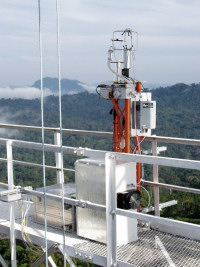Manchester Bukit Atur Measurements
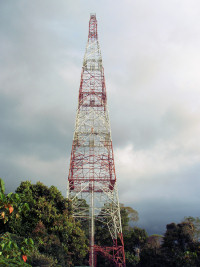
Aerosol Characterisation Instrumentation
The Centre for Atmospheric Science deployed a comprehensive suite of instrumentation to characterise aerosol physical and chemical properties at the Bukit Atur site. This instrumentation consisted of the following:
Hi-res Time of Flight Aerosol Mass Spectrometer (Hi-Res TOF-AMS) - Size resolved aerosol chemical composition 20-1000nm size range and quasi single particle composition.
Hygroscopic Tandem Differential Mobility Analyser - Aerosol size resolved hygroscopic properties, 25-400nm size range.
Cloud Condensation Nucleus Counter coupled with a Differential Mobility Analyser and Condensation Particle Counter - Aerosol activated fraction as a function of size and super saturation, 25-500nm size range.
Differential Mobility Particle Sizer - Aerosol size distribution (electrical mobility), 3-800nm size range (lower size affected by inlet transmission efficiency).
Aerodynamic Particle Sizer - Aerosol size distribution (aerodynamic), 0.5-20µm size range (upper size affected by inlet transmission efficiency)
Multi-Angle Absorption Photometer - Total black carbon mass loading integrated over all sizes transmitted by the inlet system.
Compact Cascade Impactor - Size segregated aerosol collection for subsequent chemical analysis by ion chromatography.
Filter Sampler - Total particle collection onto baked quartz substrates for subsequent analysis for organic surfactants (to be carried out by one of our Malaysian collaborators) - Second measurement period only.
Wide Interest Bio-aerosol Sampler (WIBS) - Detection of supermicron aerosol of biological origin by UV flourescence - Part of second measurement period only.
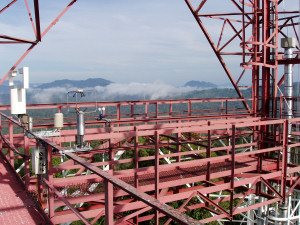
With the exception of filter and impactor sampling and WIBS all this instrumentation was located in the Manchester sea container laboratory which was positioned at the base of the 100m GAW tower, and sampled from a specially designed common inlet system with an intake located at a height of 30m on the tower. This inlet is described in more detail in the following paragraph. To aid the interpretation of the aerosol data, the meteorological parameters wind speed, wind direction, temperature and relative humidity were recorded close to the inlet intake at 30m. Additionally a Particulate Volume Monitor was also deployed at 30m to indicate whether the site was in cloud/fog, as was often the case during the night and early in the morning.
With a samplig height of 30m above the ground, it was expected that air sampled would be representative of air above the forest canopy, as this was higer than any of the trees surrounding the Bukit Atur clearning, and would also be free from any local influence by activities at the site even in the low wind speed conditions generally experienced. In addition once set up had been completed all non essential vehicle traffic was banned from the site to reduce local pollution levels.
It was intended that all Manchester measurements apart from filters and impactors would run continuously through both measurement periods with the exception of routine instrument calibrations. In practise data coverage was reduced due to problems related to power failures at the site, as well as temperature and humidity. This was particularly the case during the first measurement period. The Hi-Res TOF-AMS was also taken off line for short intervals to analyse bag samples collected at the in canopy site.
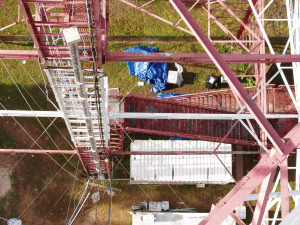
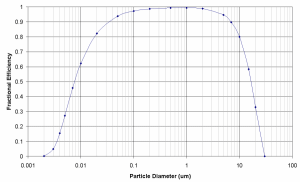
Aerosol Inlet System
Sampling aerosol under tropical conditions presented unique challenges. When warm moist air is cooled water condenses out onto aerosol particles in the air and all cool surfaces in contact with it. As all the aerosol sampling instruments operate inside an airconditioned container which for this project would be considerably cooler than the ambient air, condensation in the sampling lines and in the instruments themselves was a real concern. Additionally instruments such as condensation particle counters further cool the air as part of the measurement process. It was also thought that under some circumstances there could be a temperature gradient between the inlet intake at 30m and the ground.
To overcome these problems a new inlet system was designed which incorporated a drier to remove a significant quantity of water vapour from the airflow before it entered the container. This inlet system consisted of a 28m 15cm diameter plastic pipe covered with high performance insulation operating at a flow rate of 1500lpm. The insulation coupled with the short residence time in the pipe ensured that there was no significant internal temperature gradient between the top and bottom of this pipe. This avoided problems associated with condensation, or with solar heating driving off volatile components. At the bottom of this pipe air was ioskinetically subsampled from the centre of the flow at 35lpm, this air was then dried using a 780 tube nafion drier operating with a dry air counterflow. After the drier the sample air was decellerated to obtain laminar flow conditions and distributed to instrumentation in the container using the existing isokinetic sub-sampling system.
As with any aerosol inlet system, this system does not acheive 100% transmission across all aerosol sizes, but it has been characterised theoretically based on established loss mechanisms for the different flow regimes in the system. Additionally transmission tests were carried out in the field with identical aerosol sizing instruments located at the intake and sampling from the inlet in the container.
Flux Measurements
20Hz turbulence measurements were made using a 3d sonic anemometers mounted on a small mast secured to the 45m platform on the GAW tower. These turbulence measurements allowed eddy covariance measurements of latent and sensible heat, ozone, total and ultra-fine aerosol fluxes. In order to make these measurements additional fast response sensors were deployed on the mast.
To calculate the latent heat flux a Campbell Scientific Krypton Hygrometer was used to measure rapid fluctuations in water vapour concentration. This instrument uses UV absorption to measure these rapid fluctuations, but does not give a reliable absolute concentration, so the data from the krypton hygrometer is coupled with an absolute measurement from a Rotronic T+RH sensor.
Ozone fluxes were measured using a Guston chemiluminescent fast response sensor during the first measurement period until the instrument was damaged by water getting into the electronics. It was replaced by a ROFI instrument which uses the same measurement technique for the second period. These instruments measure rapid fluctuations in ozone concentration, but not absolute concentration as the response of the instrument changes with the age of the target disk. Thus data from these instruments is coupled with an absolute measurement from a 2B ozone analyser also mounted on the mast. The chemiluminescent material on the target disk is also sensitive to water vapour, so the water vapour measurements are used to correct for this.
Particle fluxes were measured using two TSI condensation particle counters, a model 3025 which has a lower cut of 3nm and a 3010 which has a lower cut of 10nm. The total particle flux is simply calculated from the fluctuations in the 3025 concentration, while the ultra-fine flux is calculated from fluctuations in the difference between the two concentrations. These particle counters were mounted in a cooled box fitted to the lower part of the mast. Air was sampled from a short inlet ending in a miniature impactor to prevent large particles and insects from entering the sample line. In order to prevent problems of condensation in the sample lines and the instruments themselves, a dry particle free dilution flow was added to the inlet flow before it entered the cooled box. Concentrations from the counters were then scaled to account for the dilution.
In addition to the eddy covariance flux measurements, a DMT Aerosol Sizing Probe was also mounted on the mast giving 1s size distributions over the 0.3 - 3µm size range.
As the tower was at risk of lightning strikes, and was indeed struck several times during the project, all data from instruments on the tower was transmitted back to the container using a wireless Ethernet bridge, and monitored and logged on a computer there. Additionally lightning protection was provided on all power and data cables running to the tower and interconnecting items on the tower.
